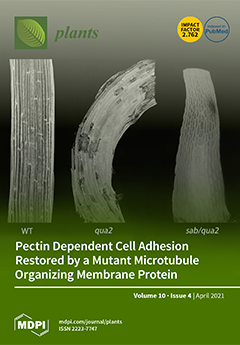Stevia rebaudiana Bertoni is a little bush, which is cultivated on a large scale in many countries for medicinal purposes and used as a natural sweetener in food products. The present work aims to conduct a protocol for stevia propagation in vitro to produce and introduce
Stevia rebaudiana plants as a new sweetener crop to Egyptian agriculture. To efficiently maximize its propagation, it is important to study the influence of stress factors on the growth and development of
Stevia rebaudiana grown in vitro. Two stevia varieties were investigated (Sugar High A3 and Spanti) against salt stress. Leaves were used as the source of explants for callus initiation, regeneration, multiplication and rooting. Some stress-related traits, i.e., photosynthetic pigments, proline contents, and enzyme activity for peroxidase (POD), polyphenol oxidase (PPO), and malate dehydrogenase (MDH) were studied. Murashig and Skoog (MS) medium was supplemented with four NaCl concentrations: 500, 1000, 2000, and 3000 mgL
−1, while a salt-free medium was used as the control. The data revealed that salinity negatively affected all studied characters: the number of surviving calli, regeneration%, shoot length, the number of multiple shoots, number of leaf plantlets
−1, number of root plantlets
−1, and root length. The data also revealed that Sugar High A3 is more tolerant than Spanti. The total chlorophyll content decreased gradually with increasing NaCl concentration. However, the opposite was true for proline content. Isozyme’s fractionation exhibited high levels of variability among the two varieties. Various biochemical parameters associated with salt tolerance were detected in POD. Namely, POD4, POD6, POD 9 at an
Rf of 0.34, 0.57, and 0.91 in the Sugar High A3 variety under high salt concentration conditions, as well as POD 10 at an
Rf of 0.98 in both varieties under high salt concentrations. In addition, the overexpression of POD 5 and POD 10 at
Rf 0.52 and 0.83 was found in both varieties at high NaCl concentrations. Biochemical parameters associated with salt tolerance were detected in PPO (PPO1, PPO2 and PPO4 at an
Rf of 0.38, 0.42 and 0.62 in the Sugar High A3 variety under high salt concentrations) and MDH (MDH 3 at an
Rf of 0.40 in both varieties at high salt concentrations). Therefore, these could be considered as important biochemical markers associated with salt tolerance and could be applied in stevia breeding programs (marker-assisted selection). This investigation recommends stevia variety Sugar High A3 to be cultivated under salt conditions.
Full article






